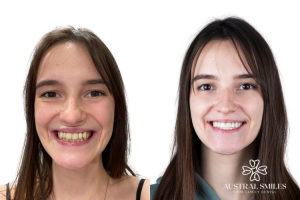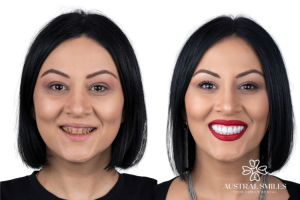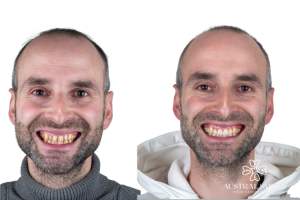Missing or Damaged Teeth? We Can Help
Dental Crowns and Bridges Austral

Bring Back Your Smile with Dental Crowns and Bridges

Find Out if Crowns or Bridges Suit You
Cracked or Worn Tooth
A crown can protect a weakened or fractured tooth. It restores strength and shape so you can chew more comfortably and avoid further damage.
Large Filling Area
If most of the tooth is filled, a crown may help. It provides support and helps preserve what remains of your natural tooth.
Missing One Tooth
A dental bridge can fill a single tooth gap. It anchors to nearby teeth and helps restore normal chewing and prevent shifting.
Multiple Missing Teeth
Bridges can replace several missing teeth in a row. They support speech and eating while helping maintain the position of remaining natural teeth.

Smile, Chew, And Speak with Ease Again
Dental crowns and bridges support more than just your smile’s appearance. Many patients in Austral notice improvements in comfort, oral function, and daily confidence after receiving these tailored restorations.
Improved Chewing
These restorations help re-establish your bite. They make it easier to enjoy meals again, especially if chewing has been uncomfortable or uneven.
Clearer Speech
Bridges can help you speak more clearly. Replacing missing teeth may improve pronunciation, especially if gaps are affecting how you form words or sounds.
Tooth Protection
Crowns support teeth with cracks or wear. They help protect the tooth from chipping or breaking during normal eating or daily use
Natural Appearance
Each crown and bridge is custom-matched to your smile. This creates a natural-looking result and helps restore balance to your appearance.

Ready to Restore Your Smile Today?
Before and After Smile Transformations
Discover real patient smile transformations in our gallery! Keep in mind that every smile is unique, so results may vary.

Dental Crowns

Dental Crowns

Dental Crowns

Dental Crowns

Dental Crowns

Dental Crowns

Gentle, Stress-Free Care
Worried about the process? You’re not alone. You’re in good hands. From preparation to final fitting, we explain each step of the procedure in clear terms to help you feel confident and in control.
Flexible Payment Options
We believe getting the care you need should feel manageable. That’s why we offer flexible payment choices, so you can restore your smile without the financial burden.
Long-Lasting, Beautiful Results
We use high-quality materials and modern techniques to create restorations that are made to last, so you can enjoy a strong, confident smile for many years to come.
Experienced Dentists
With over 30 years of combined experience, our team fabricate crowns and bridges with precision and artistry, improving both oral function and daily comfort.
Strong, Natural Smiles Built to Last
When teeth are damaged or missing, it’s not just your smile that’s affected — it’s your everyday comfort, your confidence, and even the simple joy of sharing a laugh. At Austral Smiles, we’re here to help restore what’s been lost with custom crowns and bridges that feel strong and fit seamlessly into your life.
Strong, Natural Smiles Built to Last
When teeth are damaged or missing, it’s not just your smile that’s affected — it’s your everyday comfort, your confidence, and even the simple joy of sharing a laugh. At Austral Smiles, we’re here to help restore what’s been lost with custom crowns and bridges that feel strong and fit seamlessly into your life.
 Gentle, Stress-Free Care
Gentle, Stress-Free Care
 Long-Lasting, Beautiful Results
Long-Lasting, Beautiful Results
 Flexible Payment Options
Flexible Payment Options
 Experienced Dentists
Experienced Dentists

Payment Options
We offer a range of flexible payment options to help make your dental care more manageable.
We Accept All Health Funds

Meet the Experienced Dentists at Austral Smiles
Get to know our friendly dental team, each dedicated to providing personalised care to improve your smile and oral health.
Dr. Sushmita Dahal
DEN0001028720, General Dentist
With over 18 years of experience, Dr. Sushmita Dahal has worked across private, public, and not-for-profit clinics in Australia. She combines technical precision with creative skills in dental artistry and smile rehabilitation.
Learn MoreDr. Mamata Maharjan
DEN0001586185, General Dentist
Dr. Mamata Maharjan has over 15 years of clinical experience in Sydney’s public and private sectors. She focuses on preventive dentistry, root canal therapy, and clear aligner orthodontic treatments for adults and teens.
Learn MoreDr. Bandana Shakya
DEN0001148239, General Dentist
A graduate of Progressive Orthodontic Seminars (USA, 2015), Dr. Bandana Shakya offers implants and orthodontic treatments. She provides Invisalign®, ClearCorrect®, Spark®, ClearPath® aligners and performs complex wisdom teeth extractions. She also completed implant training with Osstem.
Learn MoreDr. Sarita Adhikari
DEN0001677199, General Dentist
Since graduating in 2004, Dr. Sarita Adhikari has delivered preventative, cosmetic, and restorative dental care. She promotes patient education, empowering individuals to take active roles in managing their long-term oral health.
Learn MoreAustral Smiles
average rating
ADA
Member


Dental Crowns and Bridges FAQs
Do you have questions about crowns or bridges? Here are answers to some of the most common things our patients ask.
What's the difference between a dental crown and a bridge?
Dental crowns and bridges are both restorative treatments used to address different oral health issues.
Crowns
A dental crown, also referred to as a tooth cap, is a protective covering shaped to fit over a tooth that has lost strength due to damage or treatment. It is often placed after procedures like a root canal or when a tooth has developed a large crack or filling.
Crowns are made to blend with the surrounding teeth, both in colour and shape, for a natural-looking result. In many cases, dental crowns in Austral are recommended when a tooth is still present but no longer strong enough to function by itself.
Bridges
A bridge is used to fill a gap left by one or several missing teeth, restoring function and appearance. It includes artificial teeth supported by crowns placed on neighbouring teeth. Bridges help with chewing and also help keep nearby teeth from shifting.
These treatments are chosen based on your individual needs:
- A crown may be suggested when a tooth is still in place but no longer strong enough to function without support.
- A bridge may be used to close a gap where teeth are missing, using adjacent teeth to hold the replacement in position.
People in Austral and nearby areas often explore these options when managing tooth loss or structural damage. Your dentist will examine your teeth, gums, and overall oral health to determine the most appropriate treatment.
Which is better, a crown or a bridge?
There’s no single answer to which option is better—it depends entirely on your oral condition and treatment needs. Rather than comparing them as equal alternatives, your dentist will recommend the option that aligns most closely with your oral health needs.
To help determine the most appropriate treatment, your dentist will consider several factors:
- They will assess whether a damaged tooth is still present and can be preserved with a crown.
- They will assess if a missing tooth has created a gap that requires restoration.
- They will evaluate whether the adjacent teeth are healthy enough to support a dental bridge.
Both crowns and bridges serve important purposes, supporting everyday activities like chewing and speaking. Our dental team will provide guidance during your consultation based on a thorough clinical evaluation.
How long do crowns and bridges last?
Crowns and bridges are designed to be durable, though how long they last depends on the materials used, how well they’re maintained, and daily wear during biting and chewing.
Let’s break it down:
Crowns
- Crowns are often placed on teeth that have lost structure from wear, decay, or dental treatment.
- They often last between 5 and 15 years, depending on how they are cared for.
- Materials such as zirconia, ceramic, porcelain, or metal each offer different levels of strength and appearance.
- Molars often experience more stress, which may lead to faster wear of the crown.
- Your dental team will offer tailored advice based on how you care for your teeth, the material selected, and how your bite functions.
Bridges
- A bridge replaces missing teeth and may last over 10 years when properly maintained.
- The health of nearby teeth and gums contributes to how long they remain stable.
- Regular cleaning under the bridge is important to help prevent issues.
- Activities like grinding teeth or biting hard objects can shorten their usable period.
Do health funds cover dental crowns or bridges?
Some private health funds may contribute towards the cost of crowns or bridges, depending on the level of cover and your specific policy.
Here are the key points to understand:
- These services usually fall under the major dental category.
- Waiting periods and annual limits may apply, especially for more involved treatments.
- Benefits and contribution levels can differ between providers and policies.
During your consultation, we can give you an itemised treatment plan with item codes. This helps you confirm your available entitlements before beginning any procedure. For convenience, claims can be processed in-clinic via HICAPS.
Checking your policy with the item codes provided will give the clearest picture of your fund’s contribution.
What is the most comfortable crown option?
Comfort depends on the material used, how your bite functions, and how accurately the crown is fitted. Some patients prefer certain materials based on feel, durability, or sensitivity.
To help you compare, here are the most commonly used crown materials:
- Porcelain is often chosen for front teeth due to its smooth texture and its ability to closely match the natural appearance of tooth enamel.
- Zirconia is a dense, strong, tooth-coloured material that can feel solid in the mouth and may reduce temperature sensitivity in some patients.
- Porcelain-fused-to-metal (PFM) combines a durable metal substructure with a tooth-coloured porcelain exterior. These crowns offer a balance of strength and aesthetics but may feel slightly bulkier than all-ceramic options.
- Full metal crowns, such as those made from gold alloys, are typically thinner and highly durable. They are most commonly used on molars, where chewing forces are stronger.
If a crown feels uncomfortable after placement, your dentist can assess the fit and make adjustments to improve how it feels in your mouth.
Can a tooth with a crown get a cavity?
Yes, a crowned tooth can still experience decay, particularly around the margin where the crown meets the natural tooth.
To reduce your risk:
- Brush twice daily using fluoride toothpaste, focusing on the area where the crown meets your gums.
- Floss every day to help remove debris and plaque between your teeth and around the crown.
- Maintain regular dental check-ups to catch any signs of early decay.
Proper home care remains just as important for crowned teeth as it is for natural ones.
What are the disadvantages of dental bridges?
Bridges can be a practical option to replace missing teeth, but there are a few things to consider before making a decision.
Possible drawbacks include:
- Tooth modification: Nearby teeth must be reshaped to support the bridge.
- Dependency on neighbouring teeth: If those teeth develop problems, the bridge may be affected.
- Hygiene requirements: Cleaning under a bridge can involve more than regular flossing.
- Eventual replacement: Bridges may need to be replaced due to wear or changes in the supporting teeth or gums.
Your dentist will walk you through all the considerations so you can choose what feels right for your smile and oral health.
For those needing to replace one or more teeth, dental bridges in Austral are often chosen for their ability to restore daily comfort and stability.
How many teeth can a dental bridge replace?
The number of teeth a bridge can replace depends on several factors, including the condition of the supporting structures.
Influencing factors include:
- Support strength: Anchor teeth or implants must be strong enough to hold the bridge.
- Location: Bridges in the front of the mouth may replace more teeth due to lower bite pressure.
- Span size: Longer spans may create additional force on supporting teeth.
- Material used: Stronger materials may support longer spans.
Your dentist will assess your bite and support structures to determine a safe and suitable design for your bridge.
What's the process for getting a crown or bridge at Austral Smiles?
Receiving bridgework or a crown involves multiple stages, each planned to help you restore dental function while supporting comfort.
Here’s what to expect:
- Initial consultation: Your dentist will assess your teeth, gums, and bite. Imaging may be taken to assist in planning.
- Treatment planning: A tailored plan will be created, including material selection and the number of visits.
- Tooth preparation: The affected tooth is reshaped for a crown, or adjacent teeth are prepared for a bridge.
- Temporary restoration: A temporary crown or bridge may be placed to protect the area between visits.
- Fitting: Once ready, the final crown or bridge is checked for fit and appearance and adjusted as needed.
- Home care guidance: You'll receive instructions on cleaning and maintaining the restoration.
- Follow-up: Ongoing reviews are recommended to monitor your condition and oral health.
Whether you’re receiving a single crown or undergoing bridgework, each step is designed to support comfort, function, and long-term results.




